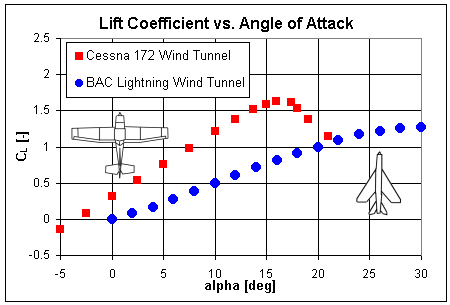The graph below shows how the coefficient of lift acts as the angle of attack increases for two different planes.

The Coefficient of Lift
compares the amount of lift (L) generated by the power
source of the
aircraft to the dynamic pressure (q)
and the area of the wing span (A).
This equation is listed here:
CL = L/( (1/2) ρv^2A
)
CL - Coefficient of Lift
L - Lift
ρ - Density of air
v - Velocity over airfoil
q -
Dynamic
pressure
This COI (Coefficient of Lift)
is a way of expressing how well the plane will perform with a given
angle of attack (the angle between the flat ground and the
cord of the airfoil). The better the
Coefficient of Lift, the more efficient the plane will fly in terms of
speed, how much it will carry and how much fuel it will burn per hour.
The graph below shows how the coefficient of lift
acts as the angle of attack increases for two different planes.

As
listed on the
graph, the two planes are a Cessna 172 and a BAC lightning. The 172 is
a plane made for short distances, at a slow rate compared to the
Lightning which is made for
supersonic speeds and agility. The Lightning also has a much shorter,
more aerodynamic wingspan. It is not coincidence that the Lightning
acts mostly linearly than the 172 that shows a
definate point where it reaches optimum efficiency. The more
aerodynamic design provides the Lightning with a good performance at
all angles of attack.